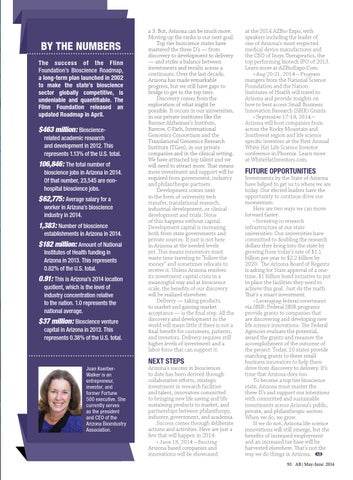By the Numbers The success of the Flinn Foundation’s Bioscience Roadmap, a long-term plan launched in 2002 to make the state’s bioscience sector globally competitive, is undeniable and quantifiable. The Flinn Foundation released an updated Roadmap in April.
$463 million: Biosciencerelated academic research and development in 2012. This represents 1.13% of the U.S. total.
106,846: The total number of bioscience jobs in Arizona in 2014. Of that number, 23,545 are nonhospital bioscience jobs.
$62,775: Average salary for a worker in Arizona’s bioscience industry in 2014.
1,383: Number of bioscience establishments in Arizona in 2014.
$182 million: Amount of National Institutes of Health funding in Arizona in 2013. This represents 0.82% of the U.S. total.
0.91: This is Arizona’s 2014 location quotient, which is the level of industry concentration relative to the nation. 1.0 represents the national average.
$37 million: Bioscience venture capital in Arizona in 2013. This represents 0.38% of the U.S. total.
Joan KoerberWalker is an entrepreneur, investor, and former Fortune 500 executive. She currently serves as the president and CEO of the Arizona Bioindustry Association.
a 3. But, Arizona can be much more. Moving up the ranks is our next goal. Top tier bioscience states have mastered the three D’s — from discovery to development to delivery — and strike a balance between investments and results across a continuum. Over the last decade, Arizona has made remarkable progress, but we still have gaps to bridge to get to the top tiers. Discovery comes from the exploration of what might be possible. It occurs in our universities, in our private institutes like the Banner Alzheimer’s Institute, Barrow, C-Path, International Genomics Consortium and the Translational Genomics Research Institute (TGen), in our private companies and in the clinical setting. We have attracted top talent and we will need to attract more. That means more investment and support will be required from government, industry and philanthropic partners. Development comes next in the form of university tech transfer, translational research, industrial development, or clinical development and trials. None of this happens without capital. Development capital is increasing both from state governments and private sources. It just is not here in Arizona at the needed levels yet. This means innovators must waste time traveling to “follow the money” and sometimes relocate to receive it. Unless Arizona resolves its investment capital crisis in a meaningful way and at bioscience scale, the benefits of our discovery will be realized elsewhere. Delivery — taking products to market and gaining market acceptance — is the final step. All the discovery and development in the world will mean little if there is not a final benefit for customers, patients, and investors. Delivery requires still higher levels of investment and a labor force that can support it.
Next steps
Arizona’s success in biosciences to date has been derived through collaborative efforts, strategic investment in research facilities and talent, innovators committed to bringing new life saving and life sustaining products to market, and partnerships between philanthropy, industry, government, and academia. Success comes through deliberate actions and activities. Here are just a few that will happen in 2014: • June 19, 2014 – Exciting Arizona based companies and innovations will be showcased
at the 2014 AZBio Expo, with speakers including the leader of one of Arizona’s most respected medical device manufactures and the CEO of Insys Therapeutics, the top performing biotech IPO of 2013. Learn more at AZBioExpo.Com. • Aug 20-21, 2014 – Program mangers from the National Science Foundation and the Nation Institutes of Health will travel to Arizona and provide insights on how to best access Small Business Innovation Research (SBIR) Grants. • September 17-18, 2014 – Arizona will host companies from across the Rocky Mountain and Southwest region and life science specific investors at the First Annual White Hat Life Science Investor conference in Phoenix. Learn more at WhiteHatInvestors.com.
Future Opportunities
Investments by the State of Arizona have helped to get us to where we are today. Our elected leaders have the opportunity to continue drive our momentum. Here are two ways we can move forward faster: • Investing in research infrastructure at our state universities: Our universities have committed to doubling the research dollars they bring into the state by growing from today’s rate of $1.1 billion per year to $2.2 billion by 2020. The Arizona Board of Regents is asking for State approval of a onetime, $1 billion bond initiative to put in place the facilities they need to achieve this goal. Just do the math. That’s a smart investment. • Leveraging federal investment via SBIR: Federal SBIR programs provide grants to companies that are discovering and developing new life science innovations. The Federal Agencies evaluate the potential, award the grants and measure the accomplishment of the outcome of the project. Today, 10 states provide matching grants to these small business innovators to help them drive from discovery to delivery. It’s time that Arizona does too. To become a top tier bioscience state, Arizona must master the three D’s and support our intentions with committed and sustainable investments across Arizona’s public, private, and philanthropic sectors. When we do, we grow. If we do not, Arizona life science innovations will still emerge, but the benefits of increased employment and an increased tax base will be harvested elsewhere. That’s not the way we do things in Arizona. 93 AB | May-June 2014
